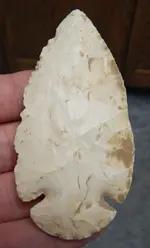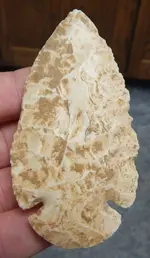You are using an out of date browser. It may not display this or other websites correctly.
You should upgrade or use an alternative browser.
You should upgrade or use an alternative browser.
What do you call this style of spearhead?
- Thread starter Plumbata
- Start date
reuellis
Sr. Member
- Joined
- Jul 25, 2014
- Messages
- 379
- Reaction score
- 635
- Golden Thread
- 0
- Location
- Abandoned Teays River Valley, WV
- Primary Interest:
- Relic Hunting
If legit I call it badass! I’m guessing a knife blade though.
The Grim Reaper
Gold Member
- Joined
- Apr 3, 2008
- Messages
- 7,805
- Reaction score
- 7,068
- Golden Thread
- 0
- Location
- Southern Ohio
- Primary Interest:
- All Treasure Hunting
Did you find it?
- Joined
- Mar 2, 2018
- Messages
- 7,322
- Reaction score
- 23,227
- Golden Thread
- 0
- Location
- Todds Point, IL
- Primary Interest:
- Metal Detecting
Killer dovetail. Not an unusual find for Peoria Co., right on the IL River. Gary
Buckleberry
Hero Member
Notching looks off, IMO.
Plumbata
Bronze Member
- #7
Thread Owner
It was 5 bucks at a flea market, the woman was selling modern household items and no other artifacts or antiques, and said her husband just found it a few days before in a Peoria Co field. She seemed completely innocent and honest and didn't know anything about "arrowheads" so there was no suspicion of deceit, plus it has some tiny fresh fleabites showing a much more "white" chert versus the more patinated beige surface so seemed legit to my untrained eye. I know that patina and polish can be faked by more sophisticated forgers but sincerely doubt that she would have gone through all that trouble to fake a damaged point to sell for 5 bucks. It still has the dirt on it as-purchased, and it appears as though the left 75% in the first pic was the rain-washed exposed portion when picked up.
I have no idea what the notching should or shouldn't look like but it seemed OK to me. Thanks for your thoughts!
Thanks for your thoughts!
I have no idea what the notching should or shouldn't look like but it seemed OK to me.
 Thanks for your thoughts!
Thanks for your thoughts!The Grim Reaper
Gold Member
- Joined
- Apr 3, 2008
- Messages
- 7,805
- Reaction score
- 7,068
- Golden Thread
- 0
- Location
- Southern Ohio
- Primary Interest:
- All Treasure Hunting
It was 5 bucks at a flea market, the woman was selling modern household items and no other artifacts or antiques, and said her husband just found it a few days before in a Peoria Co field. She seemed completely innocent and honest and didn't know anything about "arrowheads" so there was no suspicion of deceit, plus it has some tiny fresh fleabites showing a much more "white" chert versus the more patinated beige surface so seemed legit to my untrained eye. I know that patina and polish can be faked by more sophisticated forgers but sincerely doubt that she would have gone through all that trouble to fake a damaged point to sell for 5 bucks. It still has the dirt on it as-purchased, and it appears as though the left 75% in the first pic was the rain-washed exposed portion when picked up.
I have no idea what the notching should or shouldn't look like but it seemed OK to me.Thanks for your thoughts!
Thats what I figured. My opinion is it is the typical "cookie cutter" Dove you see faked by Knappers. The notching doesn't look correct, the very large base, Burlington Chert, etc. More red flags than good attributes IMO.
Gaspipe
Bronze Member
- Joined
- Sep 6, 2013
- Messages
- 1,053
- Reaction score
- 1,246
- Golden Thread
- 0
- Location
- New England
- Detector(s) used
- Garrett AT Pro; F75
- Primary Interest:
- All Treasure Hunting
No expert but I think Reaper nailed it.
dognose
Silver Member
Wash it, rub it with your fingers. Are there any mineral deposits? I dont see any. A common way they disguise a freshly made point is leave alot of dirt on them.
newnan man
Gold Member
- Joined
- Aug 8, 2005
- Messages
- 6,784
- Reaction score
- 26,333
- Golden Thread
- 0
- Location
- Beautiful Florida
- Primary Interest:
- Relic Hunting
If you have a loupe or a microscope the deposits will stick up like little grains. Fakers can't do that. They fake stains and such well though.
Not seeing much patina on it, for laying in the ground for thousands of years there should be more patina on it.
joshuaream
Silver Member
- Joined
- Jun 25, 2009
- Messages
- 3,170
- Reaction score
- 4,512
- Golden Thread
- 0
- Location
- Florida & Hong Kong
With dovetails you never know, lots of really good knappers make a lot of them. I will say this, the base and notching actually looks good for the style of dovetail from that part of Illinois. They look funny if you are used to dovetails from Indiana, Ohio & Kentucky.
Normally they are whittled down, but I wouldn’t kill it just based on the workmanship. $5 at a flea market? It would be more suspicious if it cost $100 at a flea market, there is more than $5 in the workmanship, resharpening and edge dings.
Normally they are whittled down, but I wouldn’t kill it just based on the workmanship. $5 at a flea market? It would be more suspicious if it cost $100 at a flea market, there is more than $5 in the workmanship, resharpening and edge dings.
Last edited:
- Joined
- Mar 2, 2018
- Messages
- 7,322
- Reaction score
- 23,227
- Golden Thread
- 0
- Location
- Todds Point, IL
- Primary Interest:
- Metal Detecting
Put it under a stereo microscope. It will be obvious if it is fake or real. I do agree with Reaper, the base does look a bit large for the type. Gary
Jon Stewart
Bronze Member
lot of work done for $5.00 if it is a fake.
This is a pretty typical St. Charles or Dovetail point as collectors call them. It dates to the early archaic time period in Illinois approximately 7,000-8,000 BC or so. It's made of Burlington chert which is very common for the area. It's not a spear head, but more of a knife used for butchering.
The notches are thin, which is indicative of a well made point. It looks like there's some old plow or use damage. I don't see anything out of the ordinary on this point, and it's typical of the area found.
Hippy
The notches are thin, which is indicative of a well made point. It looks like there's some old plow or use damage. I don't see anything out of the ordinary on this point, and it's typical of the area found.
Hippy
Plumbata
Bronze Member
- #19
Thread Owner
Thank you all for your thoughts, though I must admit I feel just as perplexed now as I was before posting the question!  For clarification, I'm from Peoria and got it in Peoria, and while I haven't had luck finding intact knapped pieces there, that chert seems to have been very widely represented among the broken pieces and debitage I've picked up.
For clarification, I'm from Peoria and got it in Peoria, and while I haven't had luck finding intact knapped pieces there, that chert seems to have been very widely represented among the broken pieces and debitage I've picked up.
I was brainstorming, and suppose deep thin notches would have been difficult without a copper or metal knapping tool like modern practitioners use, but guess a sharpened skinny antler tool could have been used? The expert almost fully circular flakes taken off the root of the notches also seem impressive to my untrained eye, is that normal?
I have washed the piece and will upload some additional pictures, and while I don't have a binocular microscope I do have a 60x loupe and handheld pocket microscope that goes up to 250x. What exactly are the surface deposits I should be looking for? just little raised grains or are there other features? What criteria should I be evaluating for it to be "obvious if it is fake or real"?
Thanks again!
 For clarification, I'm from Peoria and got it in Peoria, and while I haven't had luck finding intact knapped pieces there, that chert seems to have been very widely represented among the broken pieces and debitage I've picked up.
For clarification, I'm from Peoria and got it in Peoria, and while I haven't had luck finding intact knapped pieces there, that chert seems to have been very widely represented among the broken pieces and debitage I've picked up.I was brainstorming, and suppose deep thin notches would have been difficult without a copper or metal knapping tool like modern practitioners use, but guess a sharpened skinny antler tool could have been used? The expert almost fully circular flakes taken off the root of the notches also seem impressive to my untrained eye, is that normal?
I have washed the piece and will upload some additional pictures, and while I don't have a binocular microscope I do have a 60x loupe and handheld pocket microscope that goes up to 250x. What exactly are the surface deposits I should be looking for? just little raised grains or are there other features? What criteria should I be evaluating for it to be "obvious if it is fake or real"?
Thanks again!
The Grim Reaper
Gold Member
- Joined
- Apr 3, 2008
- Messages
- 7,805
- Reaction score
- 7,068
- Golden Thread
- 0
- Location
- Southern Ohio
- Primary Interest:
- All Treasure Hunting
This is a pretty typical St. Charles or Dovetail point as collectors call them. It dates to the early archaic time period in Illinois approximately 7,000-8,000 BC or so. It's made of Burlington chert which is very common for the area. It's not a spear head, but more of a knife used for butchering.
The notches are thin, which is indicative of a well made point. It looks like there's some old plow or use damage. I don't see anything out of the ordinary on this point, and it's typical of the area found.
Hippy
Theres your answer. Jeff has some of the best Dovetails out there and he knows his stuff. If he says it's good I will not disagree.
Similar threads
- Replies
- 23
- Views
- 1K
- Suggestion
- Replies
- 7
- Views
- 1K
Users who are viewing this thread
Total: 1 (members: 0, guests: 1)





